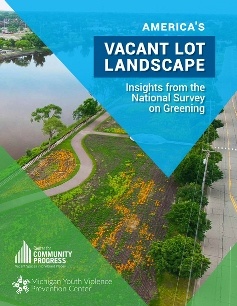How are vacant lots evolving in the United States? What strategies do practitioners consider most effective at returning purpose to these properties? What have practitioners learned in the last several years that other municipalities and organizations can benefit from? And what do organizations still need to do this work effectively?
Across the United States, non-profits, land banks, and municipalities are working to leverage vacant lots to support their communities.
Back in 2019, Community Progress and the Michigan Youth Violence Prevention Center at the University of Michigan School of Public Health conducted a national survey to gather information on vacant lot care practices with an in-depth look at the maintenance, greening, and management of vacant lots. The survey was a critical step in expanding the knowledge base and study of vacant lots. The results make clear the need to prioritize vacant lot maintenance and greening.
Those findings are now available. Survey Highlights:
- Vacant lots make up over 75% of vacant property inventories;
- The #1 reported Key to Success was resident engagement;
- Creative placemaking, new small parks, and natural habitat restoration were among the top reported activities happening on vacant lots;
- Landbank authorities and government agencies make up nearly three-quarters of organizations that both own and green vacant lots; and
- Long-term sustained funding for maintenance and greening was overwhelmingly the biggest need reported.
You can now view this 2020 report to learn what 119 organizations across 27 states shared on new trends, tactics, and lessons on maintaining and greening vacant lots.

